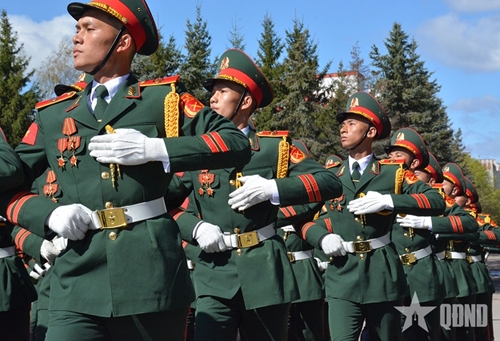Talking about challenges and differences in the training process for the upcoming parade, Lieutenant Colonel Nguyen Van Duc, an instructor from the Army Officer Training School No.1 noted that the VPA’s line-up regulations specify a march pace of 106 steps per minute, while in Russia, the march pace is faster, at 120 steps per minute. To adjust from 106 steps to 120 steps per minute according to the Russian musical rhythm, the instructors studied and proposed to reduce the foot height to 20cm, and conducted training for the troops from basic to advanced levels.
During the process, the soldiers practiced leg lifting using ropes, marching along lines to meet the technical requirements of the movement, ensuring proper, consistent steps, and swift, firm, and decisive leg movements.
Lieutenant Colonel Nguyen Van Duc held that, to ensure the soldiers have endurance for the 250-meter march at attention at a pace of 120 steps per minute, they had the soldiers wear 2kg ankle weights. Due to the lack time, the training took place at a very high intensity both day and night. They also organized additional exercises such as running, squatting, frog jumps, core training, and regularly played Russian parade music to help the soldiers adapt to the rhythm.
For the soldiers in the formation, apart from the change in marching pace, switching from black shoes to ceremonial boots also caused many soldiers to frequently suffer from heel and ankle abrasions, requiring bandaging during training. However, these difficulties have been overcome. Now, the formation has successfully completed the 250-meter march at a pace of 120 steps per minute, meeting the set requirements.
The People’s Army Newspaper would like to present some images of the troops during training session in Russia on May 6.
    |
 |
|
Lieutenant Colonel Nguyen Van Duc, instructor from the Army Officer Candidate School No.1 |
    |
 |
|
During the training session on May 6 |
Reported by Ha Phuong (from Moscow, Russia)
Translated by Minh Anh